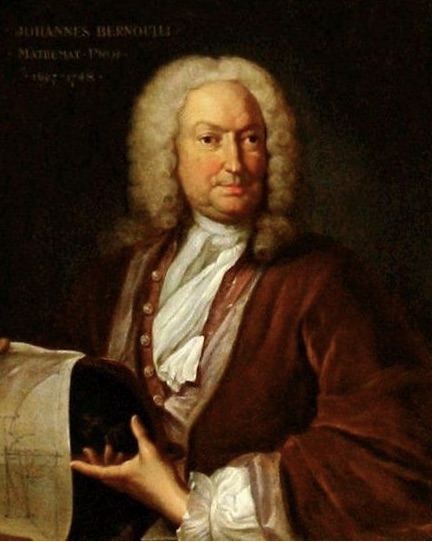
Johann Bernoulli was born on August 6, 1667 in Basel, Switzerland. The son of Nicholaus Bernoulli, Johann was one of the most accomplished mathematicians in a family that spawned several of the most eminent mathematicians in history. His father had hoped that Johann would study business at the university, so that he could take over the family spice trade. Although Johann’s first wish was to be a mathematician, this was unacceptable to his father, and, after prolonged negotiation the younger Bernoulli agreed to study medicine.
Though he took courses in medicine, Johann spent most of his time learning mathematics with his older brother Jacob who was 12 years his senior and employed as a lecturer on experimental physics at the University of Basel.
In 1691, at the age of 24, Johann went to Geneva where he gave lectures on differential calculus and from there visited Paris where he met Guillaume de L’Hopîtal. The French mathematician paid Johann handsomely to tutor him in the techniques in calculus as they were recently developed by Leibniz. The lessons formed the basis of one of the definitive books on calculus in that era, and it contained Johann’s proof of what is known as de l’Hôpital’s rule, but Bernoulli felt that L’Hopîtal did not appropriately acknowledge his contribution.
The 1690’s were a decade of high achievement for Johann, In 1691, he solved the problem of the catenary, posed by Jacob, by deriving the equation of the curve representing a cable suspended between two fixed points. Johann Bernoulli had already solved the problem of the catenary which had been posed by his brother in 1691. And between 1692 and 1693, he and Jacob worked together in a somewhat amiable rivalry on what are called “caustic curves.” In 1694, Johann submitted his doctoral dissertation in medicine involving an application of mathematics to muscular movement. In that same year, he explored the properties of the function y = xx and applied integration by parts to find the sum for several different types of series. He also discovered the addition theorems for trigonometric and hyperbolic functions. By 1695, he reputation was established and he was offered the chair of mathematics at both Halle and Groningen.
Competition between Jacob and Johann became increasingly vitriolic over the years, and reached a point of irreconcilability. In 1696, Johann proposed the famous brachistochrone problem that asks for the equation of a track joining two points of different altitude that would minimize the time required for a ball bearing to descend, under the influence of gravity, from the higher to the lower point in minimum time. Both Johann and Leibniz found solutions to the problem as did Jacob and two other European mathematicians. Johann and Leibniz, in a plan to challenge Isaac Newton, had posted the problem as a “challenge to the mathematicians of Europe.” One day, Newton, on returning from his work at the Royal Mint discovered the challenge, and applying his legendary power of concentration, solved the problem and communicated his solution anonymously the following day to the Royal Society. On reading the solution, Bernoulli announced, “Ah, I recognize the lion by his paw.”
Johann Bernoulli continued to generate important mathematical results in the early decades of the 18th century, publishing Hydraulica in 1738, but backdating it in an effort to preempt his son Daniel’s publication of Hydrodynamica in 1734. In spite of his pathological need to compete with his brother, his son and everyone else, Johann Bernoulli’s contribution to mathematics was outstanding and his tombstone inscription pays tribute to him as the “Archimedes of his age.”
